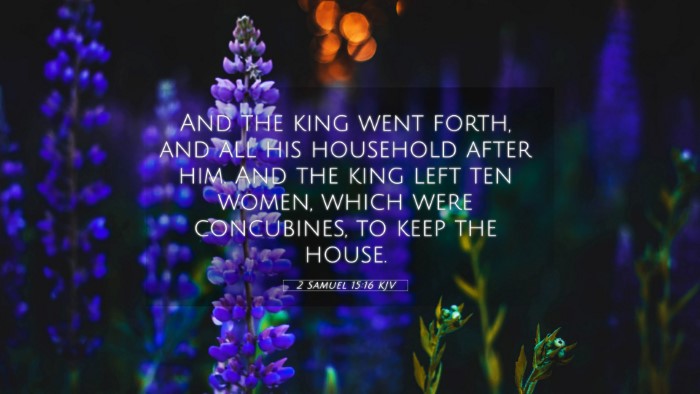Understanding 2 Samuel 15:16
2 Samuel 15:16 states: "And the king went forth, and all his household after him. And the king left ten women, which were concubines, to keep the house." This verse highlights the momentous decision of King David during Absalom's insurrection. It illustrates themes of loyalty, sacrifice, and the complex dynamics within the royal household.
Contextual Background
This passage occurs in a critical juncture in David's reign. Absalom is leading a rebellion against his father, and David is forced to flee Jerusalem. This sets the stage for a deeper examination of the relationships and decisions faced by the king.
Commentary Insights
- Matthew Henry: Henry emphasizes the significance of David’s departure as both a physical and emotional journey. This moment represents David’s acknowledgment of the conflict in his family and the loyalty required in leadership.
- Albert Barnes: Barnes discusses David leaving his concubines to take care of the palace. This indicates the king’s strategic thinking and the grave reality of the situation, showing his foresight to secure Jerusalem even amidst chaos.
- Adam Clarke: Clarke highlights the poignant sacrifice David made. Leaving behind his household symbolizes the weight of his responsibilities as king and father, and foreshadows the trials he will face with his estranged son Absalom.
Thematic Connections
This verse is rich with themes that resonate throughout the Bible, including:
- Leadership and Sacrifice: David’s decision to leave reflects the burden of leadership and the sacrifices leaders must make.
- Family and Conflict: The tension between David and Absalom illustrates the broader biblical theme of familial strife.
- Faithfulness: The concubines’ loyalty in staying behind depicts a commitment worthy of exploration through other scriptural references.
Cross-References for 2 Samuel 15:16
To enrich the understanding of this verse, we can consider the following cross-references that illustrate its themes:
- 2 Samuel 16:20-23: This passage illustrates Absalom's own insurrection and his counsel, highlighting the conflict within David's family.
- 1 Kings 1:1-4: The continued themes of succession and conflict within David's household are foreshadowed in the later events of David's life.
- Psalm 3: This psalm, attributed to David during his flight from Absalom, provides insight into his emotional state and trust in God amidst turmoil.
- Matthew 10:37: Jesus speaks about the costs of discipleship and familial loyalty, echoing the tensions seen in David's story.
- Genesis 37:31-34: The story of Jacob and Esau reflects similar familial tensions and sacrifices, illustrating the enduring nature of these themes.
- Hebrews 11:32-34: The themes of faith amid trials are highlighted in the lives of biblical leaders, including David.
- 2 Samuel 12:10-12: This passage reveals the consequences of David's earlier sins, which contribute to the problems he faces with Absalom.
Connecting Themes and Verses
Understanding the connections between these verses enhances the depth of study:
- Exploring familial loyalty in Matthew 12:50 where Jesus remarks on His true family as those who do the will of God.
- Identifying the role sacrifices play in leadership is vital; consider Philippians 2:7-8 regarding Christ's humility.
- Examining the burden of leadership in James 3:1 where teachers and leaders face stricter judgment.
Conclusion
2 Samuel 15:16 serves as a poignant moment in David’s life, illustrating the burdens of leadership, family conflict, and divine trust. By cross-referencing various passages, one can see how these themes resonate throughout Scripture, offering a richer understanding of the narratives that define the biblical text. Through resources like a Bible concordance, individuals can explore how to find cross-references in the Bible, allowing for a more integrated study of God's word.










